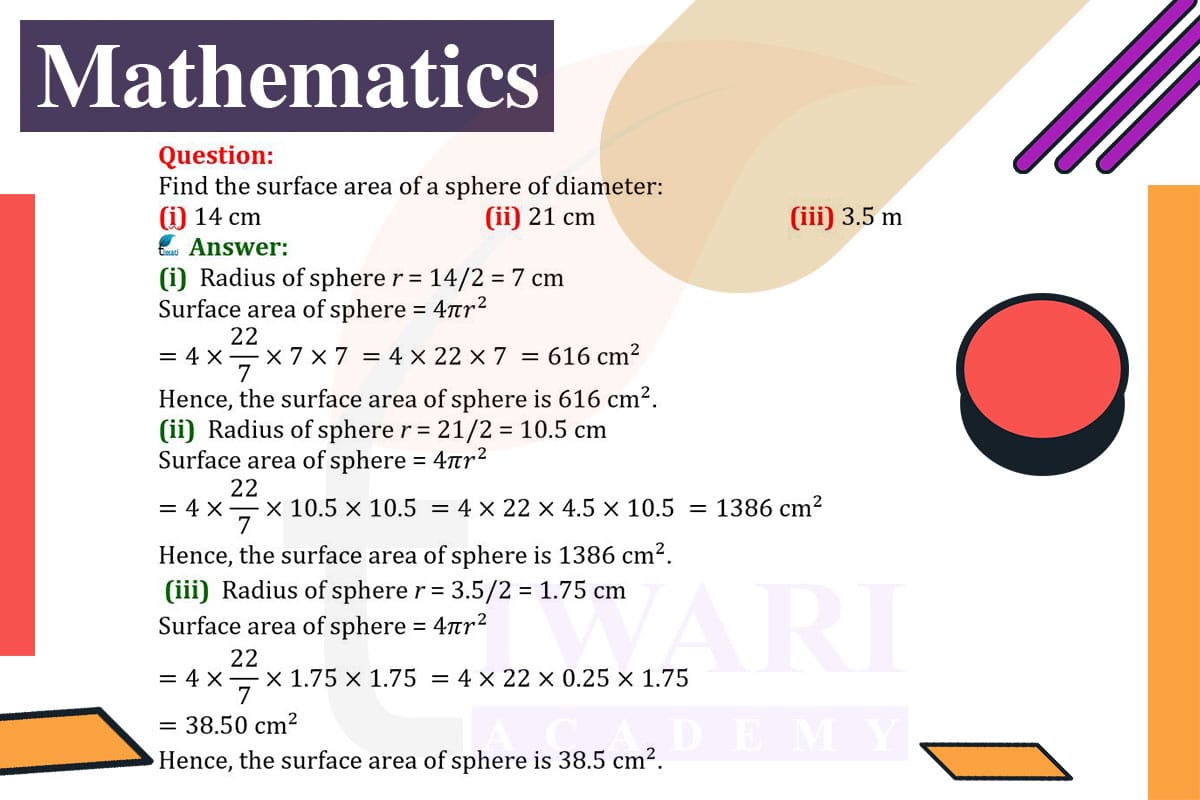To find the surface area of a sphere, we use the formula 4πr², where r is the radius. The radius is half of the diameter.
(i) For a diameter of 14 cm, the radius is 7 cm. The surface area is 4 × 3.14 × 7² ≈ 615.44 cm².
(ii) For a diameter of 21 cm, the radius is 10.5 cm. The surface area is 4 × 3.14 × 10.5² ≈ 1385.46 cm².
(iii) For a diameter of 3.5 m (350 cm), the radius is 175 cm. The surface area is 4 × 3.14 × 175² ≈ 384850 cm² or 38.485 m².
These calculations show how the surface area increases significantly with the diameter, highlighting the quadratic relationship between the surface area of a sphere and its radius.

Let’s discuss in detail
Introduction to Sphere Surface Area Calculations
Calculating the surface area of a sphere is a fundamental concept in geometry, crucial for various practical applications. The surface area is particularly important in fields like material science, architecture, and manufacturing. In this task, we calculate the surface area of spheres with different diameters: 14 cm, 21 cm, and 3.5 meters. The formula used for these calculations is 4πr², where r is the radius of the sphere, half of its diameter.
Surface Area of a Sphere with Diameter 14 cm
For a sphere with a diameter of 14 cm, the radius is half of this, which is 7 cm. Applying the surface area formula, we square the radius and then multiply by 4π. The calculation is 4 × 3.14 × 7², which equals approximately 615.44 cm². This surface area represents the total external coverage of the sphere and is indicative of the amount of material needed for its construction or decoration.
Surface Area of a Sphere with Diameter 21 cm
In the case of a sphere with a diameter of 21 cm, the radius is 10.5 cm. Using the same formula, the surface area is calculated as 4 × 3.14 × 10.5², resulting in approximately 1385.46 cm². This larger surface area corresponds to the increased diameter, demonstrating how the surface area of a sphere increases with its size.
Surface Area of a Sphere with Diameter 3.5 m
For a significantly larger sphere with a diameter of 3.5 meters (or 350 cm), the radius is 175 cm. The surface area calculation, 4 × 3.14 × 175², yields approximately 384850 cm² or 38.485 m². This substantial surface area reflects the large size of the sphere and illustrates the dramatic increase in surface area with increasing diameter.
Comparative Analysis of Surface Areas
Comparing these calculations, it’s evident that the surface area of a sphere increases rapidly with its diameter. The relationship between the surface area and the radius (or diameter) of a sphere is quadratic, meaning that even a small increase in diameter leads to a significant increase in surface area. This property is crucial in applications where the surface area impacts material usage, cost, or design considerations.
Conclusion and Practical Implications
Understanding the relationship between the diameter of a sphere and its surface area is essential in various practical scenarios, from designing spherical objects to calculating materials needed for covering or painting spherical surfaces. These examples demonstrate the importance of geometry in real-world applications and highlight the need for precise calculations in planning and design processes. The ability to accurately determine surface areas based on diameter is a valuable skill in many fields, including engineering, architecture, and manufacturing.
Discuss this question in detail or visit to Class 9 Maths Chapter 11 for all questions.
Questions of 9th Maths Exercise 11.2 in Detail


